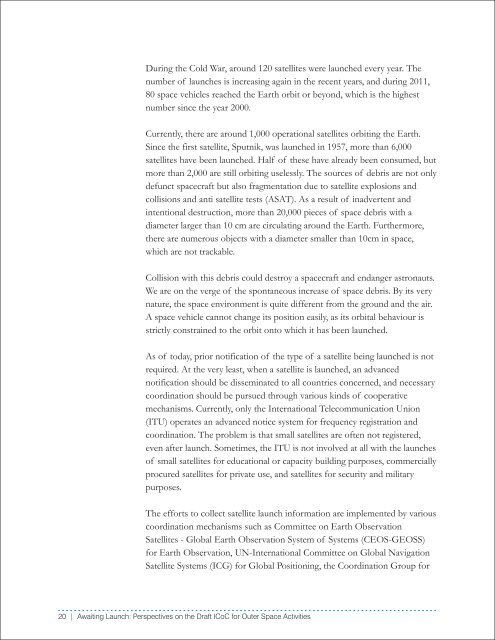AwaitingLaunch_1397728623369
AwaitingLaunch_1397728623369
AwaitingLaunch_1397728623369
Create successful ePaper yourself
Turn your PDF publications into a flip-book with our unique Google optimized e-Paper software.
During the Cold War, around 120 satellites were launched every year. The<br />
number of launches is increasing again in the recent years, and during 2011,<br />
80 space vehicles reached the Earth orbit or beyond, which is the highest<br />
number since the year 2000.<br />
Currently, there are around 1,000 operational satellites orbiting the Earth.<br />
Since the first satellite, Sputnik, was launched in 1957, more than 6,000<br />
satellites have been launched. Half of these have already been consumed, but<br />
more than 2,000 are still orbiting uselessly. The sources of debris are not only<br />
defunct spacecraft but also fragmentation due to satellite explosions and<br />
collisions and anti satellite tests (ASAT). As a result of inadvertent and<br />
intentional destruction, more than 20,000 pieces of space debris with a<br />
diameter larger than 10 cm are circulating around the Earth. Furthermore,<br />
there are numerous objects with a diameter smaller than 10cm in space,<br />
which are not trackable.<br />
Collision with this debris could destroy a spacecraft and endanger astronauts.<br />
We are on the verge of the spontaneous increase of space debris. By its very<br />
nature, the space environment is quite different from the ground and the air.<br />
A space vehicle cannot change its position easily, as its orbital behaviour is<br />
strictly constrained to the orbit onto which it has been launched.<br />
As of today, prior notification of the type of a satellite being launched is not<br />
required. At the very least, when a satellite is launched, an advanced<br />
notification should be disseminated to all countries concerned, and necessary<br />
coordination should be pursued through various kinds of cooperative<br />
mechanisms. Currently, only the International Telecommunication Union<br />
(ITU) operates an advanced notice system for frequency registration and<br />
coordination. The problem is that small satellites are often not registered,<br />
even after launch. Sometimes, the ITU is not involved at all with the launches<br />
of small satellites for educational or capacity building purposes, commercially<br />
procured satellites for private use, and satellites for security and military<br />
purposes.<br />
The efforts to collect satellite launch information are implemented by various<br />
coordination mechanisms such as Committee on Earth Observation<br />
Satellites - Global Earth Observation System of Systems (CEOS-GEOSS)<br />
for Earth Observation, UN-International Committee on Global Navigation<br />
Satellite Systems (ICG) for Global Positioning, the Coordination Group for<br />
20 | Awaiting Launch: Perspectives on the Draft ICoC for Outer Space Activities








